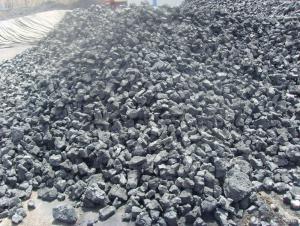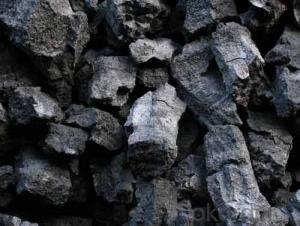The NUT Coke of Size is 20 – 40 mm
- Loading Port:
- Tianjin
- Payment Terms:
- TT OR LC
- Min Order Qty:
- 100 m.t.
- Supply Capability:
- 3000 m.t./month
OKorder Service Pledge
OKorder Financial Service
You Might Also Like
1. Structure of The NUT Coke of Size is 20 – 40 mm Description:
Coke is made by high temperature metallurgical coke for blast furnace smelting, casting and gasification. Occurring in the process of coking after recovery and purification of coke oven gas is a high calorific value of fuel, is an important industrial raw material in organic synthesis.
Coke is mainly used for blast furnace ironmaking and used for copper, lead, zinc, titanium, antimony, mercury and other non-ferrous metal smelting of blast furnace, reducing agent, compound and the function of stock column frame.
Blast furnace with Coke instead of charcoal, which laid a foundation for the large-scale of modern blast furnace, is a major milestone in the history of metallurgy.
2. Main Features of The NUT Coke of Size is 20 – 40 mm:
• Quality assurance
• Mutual benefit
• Preferential price
• Various choice
3. The NUT Coke of Size is 20 – 40 mm Images:




4. The NUT Coke of Size is 20 – 40 mm Specification:
Quality | Quality guaranteed | Rejection limits |
Moisture (As receive basis) | 7% max | --- |
Ash (dry basis) | 12.5% max | >13.5% |
Volatile Matter (dry basis) | 1.5% max | >1.8% |
Sulphur (dry basis) | 0.65% max | >0.75% |
Phosphorus (dry basis) | 0.035%max | >0.045% |
Size 20—40mm | 90%min | |
-20mm | 5%max | >8% |
+40 | 5%max | >8% |
5. FAQ
We have organized several common questions for our clients,may help you sincerely:
1) How to guarantee the quality of the products?
We have established the international advanced quality management system,every link from raw material to final product we have strict quality test;We resolutely put an end to unqualified products flowing into the market. At the same time, we will provide necessary follow-up service assurance.
2) What are coke's main physical properties?
The average heat capacity is 0.808 kj/(KGK) (100 ℃), 1.465 kj/(KGK) (1000 ℃)
Thermal conductivity is 2.64 kj/(MHK) (room temperature), 6.91 kj/(MHK) (900 ℃);
Ignition temperature (air) is 450-650 ℃.
3) How about your company?
Our company began to export coke when China cancelled 40% of coke export tariffs and quotas on January 1, 2013. We export many kinds of coke, such as CSR60 % and CSR 62% metallurgical coke (met coke), the NUT coke of 20 to 50 mm, coke breeze of 3 to 6 mm, and so on.
- Q: What is the reasonable standard of volatile content of coke
- The sulfur content in coke: sulfur is a harmful impurity of iron smelting, which reduce the quality of pig iron. The sulfur content in the pig iron is more than 0.07%.
- Q: What chemical plant used to coke
- In order to achieve better technical and economic indexes of blast furnace operation, the coke (metallurgical coke) must have proper chemical and physical properties. In addition to a large number of coke used in iron smelting and non-ferrous metal smelting (metallurgical coke), but also for casting, chemical, calcium carbide and iron alloy, the quality requirements are different. Such as foundry coke, generally require large size, low porosity, high fixed carbon and low sulfur; chemical gasification, strict requirements for strength, but requires good response, high ash melting point; calcium carbide and coke production requirements to improve the fixed carbon content.
- Q: Types of coke and use of coke
- Generally speaking, the use of coke in the following industries: blast furnace ironmaking, mechanical casting, calcium carbide production, processing Ferroalloy, chemical fertilizer, gas and high-tech high value-added industries
- Q: What kind of coke is needed for smelting special steel
- It is necessary to add coke, pellet, sinter ore, ore and other materials into the blast furnace in a certain proportion, batch and sequence, and then to produce molten iron in the reducing atmosphere of the blast furnace
- Q: How much coal can a kilogram of coal weigh?
- The ratio is about 1 to about 0.7, that is, about 1 kilograms of coking coal can produce a total of about 0.7 kg of coke
- Q: What is the amount of waste gas produced by a ton of coke burning
- Process for producing coke, coke oven gas and coking chemical products by thermal decomposition and coking.
- Q: What are the ingredients of coke
- Under the condition of isolated air, the bituminous coal is heated to 950-1050 DEG C, and finally, the coke is made by drying, pyrolysis, melting, bonding, solidification and shrinkage. Coke obtained from high temperature coking for blast furnace smelting, casting and gasification. Coke oven gas produced in the process of coking and recovery is not only a high calorific value of fuel, but also an important industrial raw material for organic synthesis.
- Q: What does the M40% and M25% mean in the analysis of coke?
- (2) mainly used in: Coal Science and Technology (first level), coal processing and utilization (level two), coal chemistry and coal quality analysis (level three)
- Q: What are the criteria for coke classification and how to distinguish between primary and two grade coke?
- 4, coke in volatile coke: according to the volatile content of coke can determine maturity. Such as volatile than 1.5%, said coke; volatile matter less than 0.5 - 0.7%, said too much, generally mature metallurgical coke volatile is about 1%.5, the moisture in the coke: water fluctuation will make coke measurement is not allowed, thus causing the furnace condition fluctuation. In addition, coke moisture will increase the M04 high, M10 low, to the drum index error6, coke screening composition: grain size of coke in blast furnace smelting. It is very important to China in the past, coke size requirements: on the coke oven (1300 - 2000 square meters) of coke particle size greater than 40 mm; medium and small blast furnace coke particle size greater than 25 mm. But some mills tests show that the coke 40 - 25 mm in size as well. More than 80 mm coke to whole, little change in its size range. So the coke size uniform, large gap, small resistance, the furnace is running well.
- Q: What is the difference between coke and coking coal
- Metallurgical coke is coke, coke, iron alloy coke and non-ferrous metal smelting coke for metallurgical coke collectively. More than 90% are used in blast furnace, the furnace coke often called metallurgical coke. Metallurgical coke quality standard Chinese formulation (GB/T1996-94) is the blast furnace quality standards.Gasification coke is a kind of coke, which is specially used in the production of gas. It is mainly used in the fixed bed coal gas producer with solid slag discharging. It is used as the raw material to produce CO and H2 gas
Send your message to us
The NUT Coke of Size is 20 – 40 mm
- Loading Port:
- Tianjin
- Payment Terms:
- TT OR LC
- Min Order Qty:
- 100 m.t.
- Supply Capability:
- 3000 m.t./month
OKorder Service Pledge
OKorder Financial Service
Similar products
Hot products
Hot Searches
























